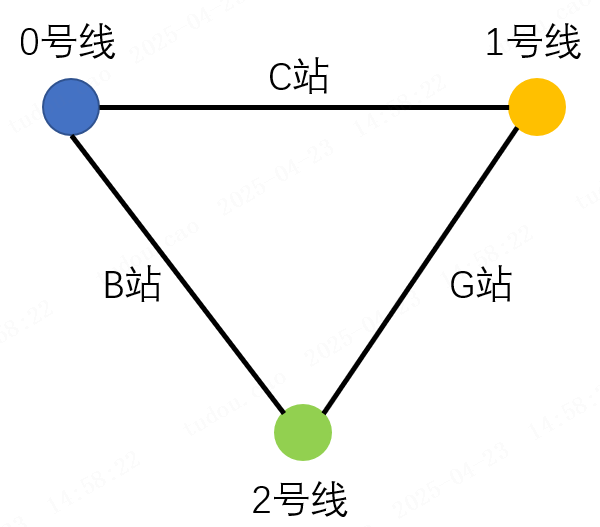题目
已知某市运营了N条地铁线路,市民在乘坐地铁时单条线路通票2元,换乘一次加1元。给出N条线路的所有站名列表,请帮乘客寻找从出发站到目的站最便宜的地铁换乘方案,并输出票价。每条地铁线路不包含环路,即没有相同站名。
输入:
第一行为地铁线路条数N,范围是[1, 1000]
第二行到第N+1行,每条线路依次包含的站名,每个站名包含的字符个数不超过100,站点个数也不超过100,依次用空格隔开,不同线路中相同的站点名表示是一个换乘站
第N+2行,出发站和目的站,用空格隔开
输入保证:若可达则为唯一解
输出:
第一行按出发站-换乘站(可以是多个)-目的站的格式输出换乘方案的字符串
第二行输出换乘方案的总票价
如果没有任何方案实现出发站到目的站,只输出一行:NA
样例:
输入:
3
A B C D F
C E G H
B G I J
A J输出:
A-B-J
3解释:

一号线有A,B,C,D,F五个站点,二号线有C,E,G,H四个站点,三号线有B,G,I,J四个站点。从A站到J站的最省钱换乘路线是经B站换乘,票价3元
代码
思路:注意本题目的地铁计费方式是按乘坐的线路条数计费的,票价 = 乘坐的地铁线路条数 + 1.所以这道题目构建图的时候应该以线路为节点去构建。


如图,根据起始和结束站点首先确定出来起始站,终点站的线路,然后以线路为节点去构建图,连接路径为换乘站,这里我用的是用邻接表去构建。
流程:
输入处理——站点与线路建立映射——直接到达检查——邻接表构建——BFS(对线路进行广度优先遍历)——路径回溯与打印输出
(代码即提交代码,注释为考后复盘所写)
from collections import defaultdict, deque
# If you need to import additional packages or classes, please import here.
def func():
N = int(input())
lines = []
for i in range(N):
line = list(map(str, input().split()))
lines.append(line)
start, end = list(map(str, input().split()))
'''
N = 3
lines = [['A', 'B', 'C', 'D', 'F'], ['C', 'E', 'G', 'H'], ['B', 'G', 'I', 'J']]
start, end = 'A', 'J'
'''
# 创建一个默认值为空列表的字典,用于存储每个站点(station)对应的地铁线路(lines)
station_to_lines = defaultdict(list)
# 特性:当访问字典中不存在的键(key)时,自动创建该键,并赋予一个默认值(此处为 list,即空列表)
for line_idx, stations in enumerate(lines):
for s in stations:
station_to_lines[s].append(line_idx)
# station_to_lines: defaultdict(<class 'list'>, {'A': [0], 'B': [0, 2], 'C': [0, 1], 'D': [0], 'F': [0], 'E': [1], 'G': [1, 2], 'H': [1], 'I': [2], 'J': [2]})
# 判断一下,起始点跟结束点是不是在同一条线路上,如果是,直接输出2,表示不用换乘,票价2元
found_direct = False
for line_idx in station_to_lines[start]:
# station_to_lines[start]: [0],起始站有可能是换乘站,需遍历所有线路
if end in lines[line_idx]:
print(f"{start}-{end}")
print(2)
exit()
# 构建邻接表,记录一条线路上和其他线路的换乘站点
adj_with_s = defaultdict(list)
for s in station_to_lines:
line_list = station_to_lines[s]
for i in range(len(line_list)):
for j in range(i + 1, len(line_list)):
l1 = line_list[i]
l2 = line_list[j]
adj_with_s[l1].append((l2, s))
adj_with_s[l2].append((l1, s))
# adj_with_s: defaultdict(<class 'list'>, {0: [(2, 'B'), (1, 'C')], 2: [(0, 'B'), (1, 'G')], 1: [(0, 'C'), (2, 'G')]})
# BFS初始化
start_lines = station_to_lines[start]
# start_lines: [0],起始站经过的地铁线路列表
end_lines = set(station_to_lines[end])
# end_lines: {2},终点站经过的地铁线路列表,转换为字典
# dist数组用来记录从起始线路到各条线路的最短距离,初始化为-1表示尚未访问
# 在题设计费方式下,不可能踏入同一条线路两次
dist = [-1] * N
# prev记录路径来源
prev = {}
# 辅助队列q
q = deque()
# 经过起始站的所有线路距离为0,标记为已访问过,并入队
for line in start_lines:
dist[line] = 0
q.append(line)
target_line = -1
found = False
while q: # 当队列不为空时
# 队头弹出节点
current_line = q.popleft()
# 如果弹出的线路经过终点,则结束
if current_line in end_lines:
target_line = current_line
found = True
break
# 遍历当前线路的相邻线路(换乘线路)
for neighbor_line, s in adj_with_s.get(current_line, []):
# 更新最短换乘次数
# get输出[(2, 'B'), (1, 'C')],0号线地铁可在B站换乘2号线,在C站换乘1号线
if dist[neighbor_line] == -1 or dist[current_line] + 1 < dist[neighbor_line]:
# 若换乘线路未被访问过,或当前线路换乘过去的代价小于目前到达该线路的代价,则更新
dist[neighbor_line] = dist[current_line] + 1
prev[neighbor_line] = (current_line, s) # 记录前驱线路和换乘站点
q.append(neighbor_line) # 相邻换乘线路进队,执行下一层BFS
# dist = [0, 1, 1],说明从B站出发,到达0号线不需要换乘,到达1号线和2号线均需要换乘1次
# prev = {2: (0, 'B'), 1: (0, 'C')},说明到达2号线需通过B站从0号线换乘过来,到达1号线需通过C站从0号线换乘过来
if not found:
# 没找着,返回false
print("NA")
exit()
else:
# 找着了,开始回溯路径
# path记录中间换乘站点
path = []
current_line = target_line
# 在记录前驱换乘的prev里面找下去
while current_line in prev:
current_line, s = prev[current_line]
path.append(s)
# 这是逆序的,所以还得翻转一下
path.reverse()
# 然后按题设要求打印输出就行了
res_path = start
for i in range(len(path)):
res_path = res_path + '-' + path[i]
res_path = res_path + '-' + end
print(res_path)
k = len(path)
cost = k + 2
print(cost)
# please define the python3 input here. For example: a,b = map(int, input().strip().split())
# please finish the function body here.
# please define the python3 output here. For example: print().
if __name__ == "__main__":
func()知识点
(1)defaultdict(list)
-
defaultdict是什么?-
来自
collections模块,是 Python 内置字典(dict)的增强版。 -
特性:当访问字典中不存在的键(key)时,自动创建该键,并赋予一个默认值(此处为
list,即空列表)。
-
-
list的作用:定义字典的默认值类型为空列表。当新键首次被访问时,会自动初始化一个空列表作为值(value)。 -
适用场景
-
需要将数据按键分组存储为列表时,避免手动检查键是否存在。
-
例如:统计每个站点所属的地铁线路(一个站点可能属于多个线路)。
-
若用普通字典实现相同功能,需手动检查键是否存在,defaultdict(list) 简化了这一过程,代码更简洁高效:
station_to_lines = {}
for station, line in stations_info:
if station not in station_to_lines:
station_to_lines[station] = [] # 手动初始化空列表
station_to_lines[station].append(line)其他常用值:
-
defaultdict(int):默认值为 0(用于计数) -
defaultdict(set):默认值为空集合(用于去重) -
defaultdict(lambda: "默认值"):自定义默认值
(2)BFS,广度优先遍历
参考:
深度优先与广度优先遍历算法详解:图遍历策略比较-CSDN博客![]() https://blog.csdn.net/qq_54708219/article/details/132469396广度优先遍历是通过辅助队列来实现的。
https://blog.csdn.net/qq_54708219/article/details/132469396广度优先遍历是通过辅助队列来实现的。
(3)字典的get方法
adj_with_s.get(current_line, [])
-
作用:当 `current_line` 不在字典中时,返回默认值空列表 `[]`
-
优点:确保返回值始终是列表类型
-
适用场景:需要安全操作返回值时(例如遍历、拼接等后续操作)
adj_with_s.get(current_line)
-
作用:当 `current_line` 不在字典中时,返回 `None`
-
风险:后续操作可能因 `None` 引发 `TypeError`
-
适用场景:明确知道键存在,或需要 None 作为特殊标记时

























 被折叠的 条评论
为什么被折叠?
被折叠的 条评论
为什么被折叠?










